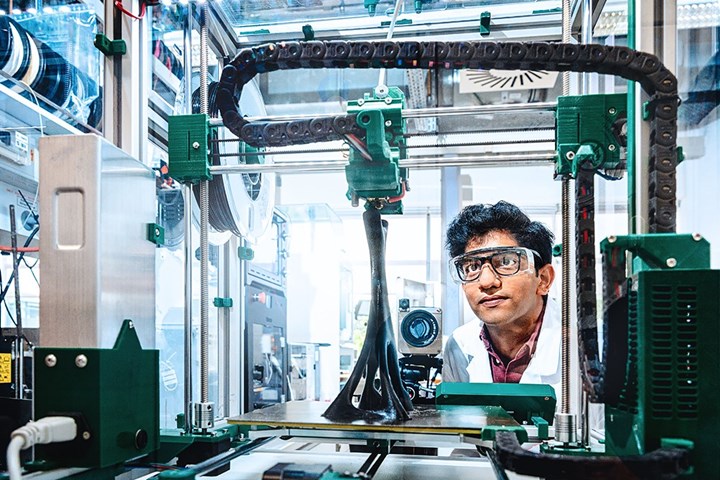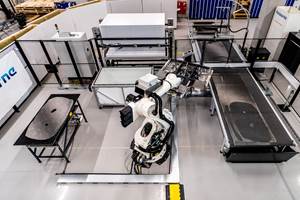Fraunhofer Cluster of Excellence Programmable Materials CPM develops 4D printing technology
The technology adds the dimension of time (1D) to the dimension of space (3D), enabling the shape of predefined, printed polymers to be altered at a later point in time when exposed to heat.

Dilip Chalissery develops the process technology for 4D printing at Fraunhofer IAP. Photo Credit: Potsdam Science Park, sevens+maltry photographers
The Fraunhofer Cluster of Excellence Programmable Materials CPM (Fraunhofer CPM, Freiburg, Germany) has developed a 4D printing technology that can alter the shape of predefined, printed polymers when heated, shrinking them by up to 63%, according to a test performed on rod-shaped samples. Fraunhofer CPM says in the future, such technologies could be used to produce parts that exhibit a specific behavior only after they take their predefined shape, using fasteners in the assembly components in the medical technology, mechanical engineering, automotive and aviation industries as examples.
How does 4D printing work? According to Fraunhofer’s team of researchers, the technology adds the dimension of time, or 1D, to the dimension of space, or 3D. In this way, objects can be printed from shape memory polymers that can change their shape once at a later point in time when exposed to heat. Specific curvatures are also possible in a targeted manner.
“We initially started with a relatively simple rod geometry, but ultimately we were able to produce more complex hollow cylinders and hollow cuboid-shaped samples,” says Dr. Thorsten Pretsch from the Fraunhofer Institute for Applied Polymer Research IAP, who is coordinating the project at Fraunhofer CPM. “For all the geometries we investigated, we specified the desired material behavior in advance.”
There are generally two ways to adjust the response to a temperature increase, researchers note. The first is the choice of material — here the researchers developed a new thermoplastic polyurethane (TPU), with shape memory properties. The team also showed that the findings gained from 4D printing can also be transferred to another thermoplastic polymer: They produced shrinkable printed objects from the bio-based polymer polylactic acid (PLA). The second possibility lies in the management of the printing process.
“The key is that we give the materials very little time to cool down during printing. As a result, drastic internal stresses are stored in the material. The subsequent shrinkage effect is then very pronounced,” says Pretsch. In short, the choice of material, processing temperature and printing speed can be used to adjust not only the shrinkage behavior, but also the curved state.
The first step in the project was to develop the material and transfer the findings from TPU to PLA. The second step was to develop a demonstrator, a door opener that is shrunk onto a door handle so that it can be operated with the elbow without hand contact. Disassembly is simple: By reheating, the door opener detaches from the handle without leaving any residue. When the print object is no longer needed, it can be ground and reprocessed into filament that can be used at least one more time for 4D printing.
“The concept is holistic and future-oriented. In terms of a cradle-to-cradle approach, we have gone through the entire product cycle — from the selection of monomers and polymer synthesis to the 4D printing of a demonstrator and its mechanical recycling,” Pretsch summarizes.
The four Fraunhofer institutes contributed their specific expertise. The Fraunhofer IAP synthesized the shape memory polymer, further developed the 4D printing technology and carried out the mechanical recycling; Linda Weisheit from the Fraunhofer Institute for Machine Tools and Forming Technology IWU developed the concept of programmable stiffness of the 4D materials; and the Fraunhofer Institute for Industrial Mathematics ITWM conducted mathematical simulations to design the demonstrator.
“For example, we investigated how the force is distributed in the door opener when it is loaded. We were also interested in finding out which design is better in terms of material consumption,” explains Dr. Heiko Andrä. The practical tests took place at the Fraunhofer Institute for Mechanics of Materials IWM. “Here, for example, the question was which torques occur when the door opener is loaded,” explains Dr. Tobias Amann.
The results of the project were published in the journal Macromolecular Materials and Engineering.
Related Content
Airbus selects Airborne to supply automated ply placement system
The pick-and-place system with software-driven automated will be the first in Airbus facilities, enabling highly efficient and flexible dry fiber preform manufacture for A350 structures.
Read MoreBroetje-Automation demonstrates rCF placement via AFP
Through the ScrapSeRO project, the system integrator and machine builder successfully processed recycled composites, in addition to more traditional materials, via its highly flexible Staxx One system.
Read MoreOptimizing robotic winding of composite tanks and pipes
Pioneer in mandrel-based reinforced rubber and composite products, TANIQ offers TaniqWindPro software and robotic winding expertise for composite pressure vessels and more.
Read MoreLarge-format 3D printing enables toolless, rapid production for AUVs
Dive Technologies started by 3D printing prototypes of its composite autonomous underwater vehicles, but AM became the solution for customizable, toolless production.
Read MoreRead Next
Developing bonded composite repair for ships, offshore units
Bureau Veritas and industry partners issue guidelines and pave the way for certification via StrengthBond Offshore project.
Read MoreAll-recycled, needle-punched nonwoven CFRP slashes carbon footprint of Formula 2 seat
Dallara and Tenowo collaborate to produce a race-ready Formula 2 seat using recycled carbon fiber, reducing CO2 emissions by 97.5% compared to virgin materials.
Read MoreVIDEO: High-volume processing for fiberglass components
Cannon Ergos, a company specializing in high-ton presses and equipment for composites fabrication and plastics processing, displayed automotive and industrial components at CAMX 2024.
Read More
























